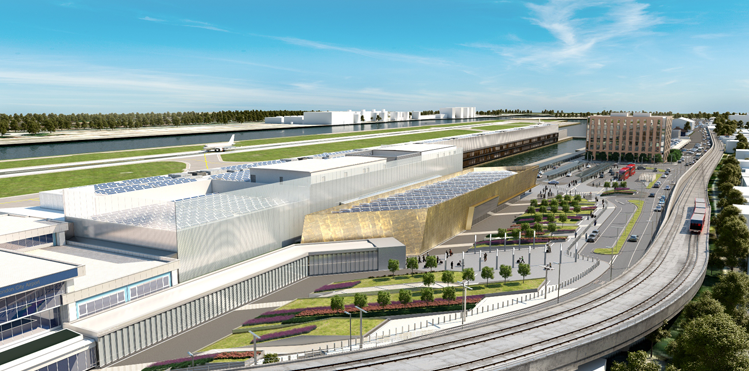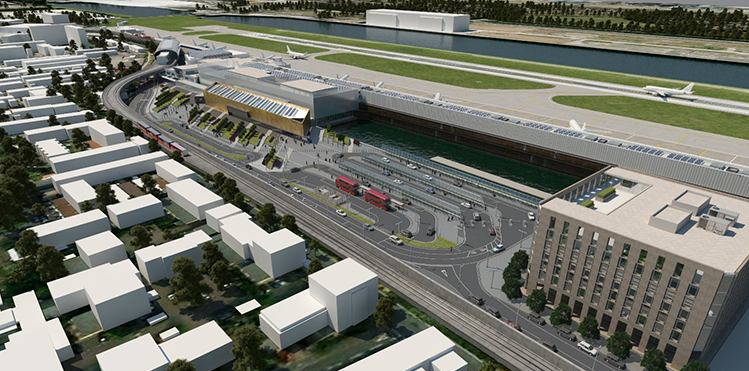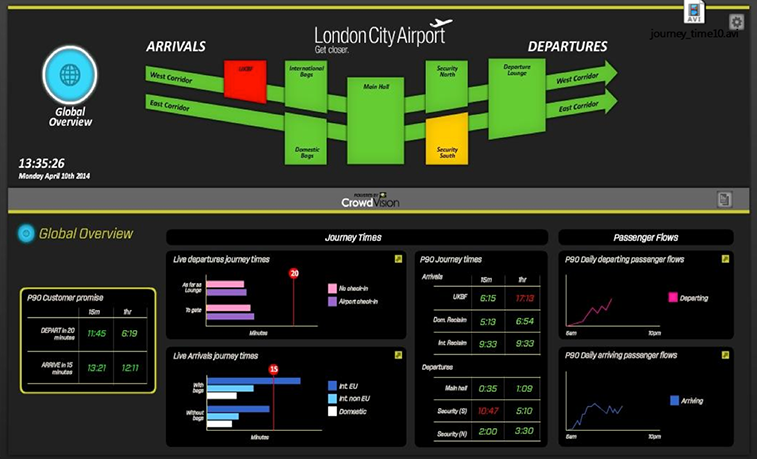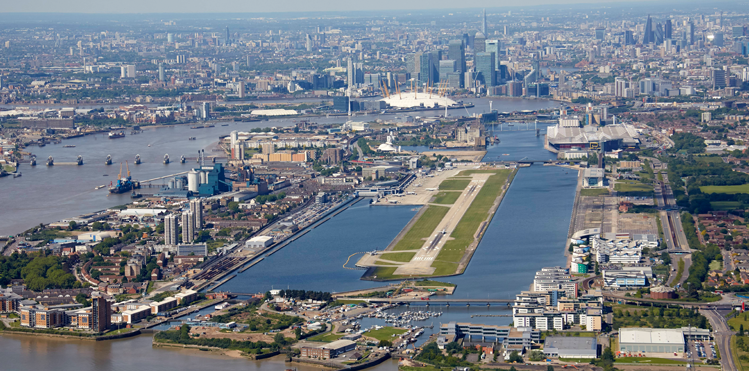Positioned at the centre of one of the world’s biggest and most prosperous cities, London City is arguably the UK’s only truly metropolitan airport. Just 20 minutes from the City of London, it can claim greater proximity to the UK’s capital than any other of the eight airports serving the region, and as such is able to offer its passengers an unparalleled proposition that marries location, convenience and speed. The continued growth in its throughput reflects the value that this proposition holds for its primarily business passenger traffic – but the airport’s flourishing success is also proving to be its foremost challenge. London City is now 27 years old and still operates out of its existing 1987 terminal, originally built to handle a maximum 100,000 passengers a year. Last year LCY served 3.7 million passengers, and expects to handle in excess of four million travellers by the close of 2015.
The long-awaited go-ahead to expand
Expansion of the gateway’s facilities has long been needed, and earlier this month London City Airport won the battle for permission to execute its development plans, fought over for almost two years in what CEO Declan Collier deems the “very frustrating” London development process. The airport negotiated over regional objections to its growth, and having secured Newham County Council’s backing has cleared the way for a £200 (€270m) million development. The expansion will provide the capacity needed to handle airport’s escalating passenger numbers – now almost 40 times what the existing infrastructure was designed to cope with – and will eventually see throughput rise to six million a year. An increase in runway capacity will open a wealth of new markets not currently served from the gateway and vitally, while Heathrow and Gatwick struggle in the skirmish for a new runway, a heightened number of movements at London City Airport will ease the pressure of swelling passenger numbers on the over-stretched airport capacity of the South East.

This year throughput at London City is expected to rise by 400,000 to exceed four million – 40 times the number of passengers the infrastructure was designed to handle when it was built in 1987, and as the vibrant city of London booms the thriving airport’s catchment too continues to expand – the borough of Newham in which it is situated is a seedbed of housing development and urban growth. Newham Council’s approval of the airport’s development plans has cleared the way for an expansion that by 2023 will see the airport capable of handling six million passengers.
“Around 140 million passengers were handled through the London airport system last year,” Collier said, “and we expect that that to grow by 30-35 million passengers over next five to eight years. The system is already strained and we know we need to build new capacity – the Airports Commission is currently looking into how we can increase capacity from 2030 out – but what we mustn’t forget is that there’s a real need to optimise capacity usage while the decision is made – and in the period between now and 2030.”
Collier has explained that the development of London City Airport will conclude in 2023, with terminal extensions to the west and to the east, seven additional aircraft parking stands and a new parallel taxiway. The increased runway capacity will mean that the airport is able to increase the number of flights from the current 70,000 a year to the 111,000 permitted by the council – slightly fewer than the 120,000 limit bid initially made by the airport – and will enable more take-offs and landings at peak times.
At present, the airport’s close proximity to the city means that its runway has steep landing and take-off requirements and can only be used by specially certified aircraft and crews, so the runway development offers real possibilities for the airport. “It will allow us to handle the next generation of regional aircraft, which are quieter, cleaner, more fuel efficient, and have a much greater range,” Collier added. “That greater range is presents huge opportunity for London City Airport, and we see ourselves being in a position to handle direct flights from destinations in the Gulf and Turkey and Russia down into North Africa, and from the west direct connections from Toronto, Montréal, Chicago and Boston. We already have a twice-daily New York service, but it will be possible to expand those services in the future with these new facilities. It’s something that’s really exciting.”

London City Airport’s runway development will create important opportunities for the thriving technological industry of East London in which it is situated. The expansion of its airfield will enable the airport to handle next-generation aircraft with greater range, opening a world of possibility to connect to tech hub cities like Boston and Istanbul. “This is a really important thing for the tech industry,” Collier said, “and such connections would be very attractive to airlines.”
Delivering more short and eventually medium-haul aviation capacity for the UK, the airport will act as a catalyst for inward investment in East London, connecting its 60% business passenger base to the commercial centres of the world. A further 1,500 new jobs will be created, and the expansion will double the economic contribution that the airport makes to its region to £1.5 billion (€2bn) a year.
The Smart Airport Experience
Processing its passengers with speed and efficiency is fundamental to London City’s proposition, and over the next eight years as the airport develops technology will play a vital role in its growth. The time in which the airport awaited the permission to expand was a period of much innovation, during which technology enabled it to make the most of its existing facility, and now the personalised approach it has applied to managing its assets, Collier explained, will postpone the urgency with which the development needs to take place – ensuring it can be conducted in the best way to proof the airport for further growth.
At the crux of the airport’s passenger experience is the 20/15 proposition – the promise to its customers that when departing they can move from the Departure Lounge entrance to their gate in 20 minutes, and from Arrivals Hall to taxi or train within 15. “We started about 18 months ago looking at new ways of using technology to ensure that we deliver on our proposition, and to ensure that we can make that guarantee to our customers,” Collier said. “We devised a system called the Smart Airport Experience – a combination of different technologies that all sit on a foundation of crowd-sensing camera technology. The airport and its entire operation and physical surroundings are covered by almost 200 cameras, which measure in real time what’s actually happening in the airport for our arriving and departing passenger processes and for our airline operations – on the ramp and around the taxiways.”
The Smart Airport Experience system enables Collier and his team to track, understand and better manage the flow and behaviours of passengers and enables them to interact with travellers at key points throughout the airport journey. Measuring 100% of passenger movement, it provides powerful real-time and historical data – meaning the airport can better deliver its promise to its customers and plan for the future – prioritising investment in the right areas. “It means that on a minute-to-minute basis we receive real-time information, which signals to us how the airport is running. Effectively it’s like a system which monitors how your body is behaving and tells you what your pulse rate is, your respiration, when issues of distress start to arrive,” Collier furthered. “It uses a traffic light system to show when the facility is starting to come under pressure – for instance if there are queues building up at check-in, a simple graphic will turn from green to orange to indicate to us that there’s a problem, and we can then go into that in greater detail – right down to the check-in desk or the individual automated check-in machine and get resources there.”

London City Airport’s Smart Airport Experience system features 192 fisheye cameras, which interconnect throughout the airport in a sophisticated algorithm to measure 100% of passenger movement. A simple ‘traffic light’ graphic indicates to Collier and his team if issues begin to arise. The application of the technology is wide-ranging – and is being used as the airport continues to develop its customer service tools and mobile app.
The recent introduction of a common use check-in system for Flybe and CityJet flights has further expedited the airport journey for London City’s passengers, “and we’ve been testing and trialling two different forms of self-bag tag and drop, which has given us a massive increase in capacity and has facilitated 60-second check-in,” Collier said. “We’re also known for the speed at which we process queues through security, and in the last couple of months we’ve introduced our gen-two security system – we hope that when we complete the trial by the end of the first quarter of the year that we’ll be rolling it out across our full operation.” Last year the airport also introduced automated e-gates, which are now being used by 70% of its passengers – the highest use of e-gates of any airport on the British Isles.

Declan Collier, CEO, London City Airport: “Airports have to agree that consistency is important. To do this they have to back off the notion that every other airport is a competitor – of course we are, but we have a common goal, and that is to make the airport experience a pleasurable experience for our customers by having more consistent approaches to how we treat the passenger.”
Collier’s ultimate vision is to make the airport fully common use for all of is airlines, which, he says, would effectively eliminate queues from check-in. His ambition is to implement this between now and 2016, but he stressed that for the passenger experience to truly improve change must be made at not an individual, but industry level. “I think first of all airports have to agree that consistency is important,” he said. “To do this they have to back off the notion that every other airport is a competitor – of course we are, but we have a common goal, and that is to make the airport experience a pleasurable experience for our customers by having more consistent approaches to how we treat the passenger. We must work with the airline industry, with our regulators and licensors and security agencies around the world, to try to come up with common levels of process. Right now it isn’t seamless. Not yet, but it’s getting there – and that’s what we have to focus on for the future.”
The ACI EUROPE Best Airport Awards recognise excellence and achievement across a whole range of disciplines relating to airport operations, and for three consecutive years London City Airport has been declared the winner of the Best Airport, Under 5 Million Passengers award. Award entries are assessed by a prestigious panel of expert judges and key institutional stakeholders, and this year winners will be announced in front of an audience of 400 industry leaders as part of the Gala Dinner at the ACI EUROPE General Assembly, Congress and Exhibition 2015 in Prague, 24-26 June. Make sure to enter your airport before the deadline on Friday 27 March.
» More information on the ACI EUROPE Best Airport Awards 2015
» Enter your airport before Friday 27 March
» More information on the ACI EUROPE General Assembly, Congress and Exhibition 2015








